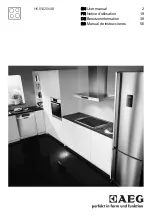
26
27
Connecting the Sauna Stove to the
Built-in Chimney
!!! The cross sectional area of the
chimney smoke flue must not be less
than the cross sectional area of the
sauna stove smoke.
The sauna stove has one smoke hole
in the top portion of the stove; some
models, in addition, in the rear portion.
If the connection is located in the top
portion, the smoke hole located in
the rear portion of the stove must be
carefully blocked with a stopper. The
stopper must bend well to the side
upon installation into the smoke hole
in the top portion of the stove so that
it would not fall out of the hole. Angle
coupling is often required.
The opening required for connection is
measured at the base of the chimney
and must be slightly larger in size than
the transition piece of the chimney. In
the end, the transition piece is sealed
directly in the opening of the chimney
base, for instance, using fire-resistant
mineral wool. The gap around the flue
may be ca. 1 cm.
The inner corners of the chimney
opening must be bent for the flue gas
-
es to be freely released. The transition
piece of the chimney must not go too
far into the chimney. If necessary, the
piece must be shortened.
Połączenie pieca do sauny do wbu
-
dowanego komina
Średnica przewodu dymowego nie
może być mniejsza, niż średnica otwo
-
ru odprowadzającego.
Piec wyposażony jest w jeden otwór
odprowadzający dym, umieszczony
w górnej części pieca. Niektóre mo
-
dele dodatkowo posiadają otwór w
tylnej części. Jeżeli połączenie znaj
-
duje się w górnej części, otwór odpro
-
wadzający dym zlokalizowany tylnej
części musi zostać dokładnie zablo
-
kowany zatyczką. Podczas montażu
do otworu odprowadzającego dym,
znajdującego się w górnej części pie
-
ca, zatyczka musi dobrze zginać się
na bok, aby nie wypadała z otworu.
Zazwyczaj stosuje się obowiązkowo
mocowanie kątowe.
Otwór wymagany w celu podłącze
-
nia jest mierzony u podstawy komina
i musi mieć trochę większy rozmiar
niż część przejściowa komina. Na sa
-
mym końcu, część przejściowa jest
dokładnie uszczelniana bezpośrednio
wewnątrz otworu podstawy komina,
np. z pomocą ognioodpornej wełny
mineralnej. Przerwa wokół przewodu
może wynosić ok. 1 cm.
Wewnętrzne narożniki otworu komino
-
wego muszą być zagięte, aby możli
-
we było swobodne uwalnianie spalin.
Część przejściowa komina nie może
wchodzić zbyt głęboko do części ko
-
minowej. W razie potrzeby należy skró
-
cić część przejściową.
Część przejściowa komina musi
przede wszystkim zostać zabezpieczo
-
na w otworze pieca do sauny odpro
-
wadzającym dym. Następnie należy
sprawdzić czy część ta została szczel
-
nie zabezpieczona. Piec do sauny jest
instalowany w miejscu, gdzie znajduje
się otwór kominowy i przesuwany w
stronę komina. Część ta musi zostać
Drawing 16. Connecting the Sauna Stove to the Built-in Chimney
Połączenie pieca do sauny do wbudowanego komina
The transition piece of the chimney
must, in the first place, be secured in
the smoke hole of the sauna stove.
Then, it is required to check if the piece
has been tightly secured. The sauna
stove is installed in the place where
the chimney opening is located in
and is moved in the direction of the
chimney. The piece must be wrapped
in fire-resistant mineral wool, and
the stove, moved into place. When
checking whether the connections of
the chimney are tight enough, it may
occur that fire-resistant mineral wool
should be added. If the wool used for
sealing is located deeper than the sur-
face of the chimney base (ca. 1 cm),
the wool can be covered with, for
instance, plaster or decor mouldings
used for the smoke flue.
The use of flaps to connect the sauna
stove to the chimney is not mandato
-
ry, since air draft can be controlled by
means of opening the ash pan.
owinięta w ognioodporną wełnę mi
-
neralną, a piec przesunięty na miej
-
sce. Podczas sprawdzania czy połą
-
czenie z kominem jest odpowiednio
szczelne, może wydawać się, że po
-
winno zastosować się więcej ogniood
-
pornej wełny mineralnej. Jeżeli wełna
stosowana do sufitu znajduje się poni
-
żej powierzchni podstawy komina (ok.
1 cm), wełna może zostać zasłonięta
np. gipsem lub listwami dekoracyjny
-
mi do przewodów dymowych.
Zastosowanie klapek w celu połącze
-
nia pieca sauny do komina nie jest
obowiązkowe, ponieważ ciąg po
-
wietrza może być kontrolowany przez
otwieranie popielnika.


































